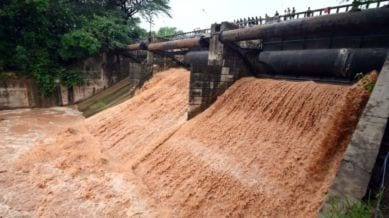Stay updated with the latest - Click here to follow us on Instagram
Amid Punjab floods, silence around water discharge from Ranjit Sagar Dam not going unnoticed
Ranjit Sagar Dam on the Ravi river is beyond the Bhakra Beas Management Board (BBMB)'s ambit and managed directly by the Punjab's irrigation and power departments.

The floods in Punjab once again bring into sharp focus the uneasy relationship between the state and the Bhakra Beas Management Board (BBMB). Established in 1966, BBMB was mandated to manage the Bhakra-Nangal and Beas projects, ensuring the distribution of water and power between Punjab, Haryana, Himachal Pradesh, Rajasthan, and Delhi.
For decades, whenever floods hit Punjab, successive state governments have pointed the finger at BBMB, accusing it of releasing water from Bhakra Dam on the Sutlej or Pong Dam on the Beas rivers without considering Punjab’s safety. But there is also a third major reservoir system—Punjab’s own Ranjit Sagar Dam (RSD) on the Ravi—beyond BBMB’s ambit, managed directly by the state’s irrigation and power departments.
monthly limit of free stories.
with an Express account.
This year, it is the Ravi river, more than the Sutlej or Beas, that has unleashed the fiercest devastation, submerging villages and farmlands in Gurdaspur, Pathankot, and Amritsar. And yet, few voices, either in government or opposition, are questioning how flood regulation was handled at RSD.
What numbers say
According to official records, the reservoir already reached its maximum permissible limit of 527.91 metres by August 25 due to relentless inflows from its catchment in Himachal and Jammu and Kashmir. Water was held up to 528.008 metres on August 26, but the dam had to release almost the same amount as the inflow—2.15 lakh cusecs outflow against 2.25 lakh cusecs incoming.
Downstream at Madhopur barrage, the flow reached 2.22 lakh cusecs, far exceeding the river’s safe carrying capacity. The pressure was such that two gates of the Madhopur barrage were damaged that very day.
The situation was aggravated when the Ujh river, carrying up to 2.06 lakh cusecs, merged with the Ravi in Gurdaspur, swelling the flow further before it snaked along the Indo-Pak border. On August 27, outflow from RSD continued at over 2.15 lakh cusecs for half the day, before being reduced.
But on August 29, discharge was again raised to over 1 lakh cusecs, when several villages in Pathankot, Gurdaspur and Amritsar were already under water. Even by August 31, when inflows had dropped to just 22,000 cusecs, the dam was still releasing 42,000 cusecs to create storage space, prolonging stress in the flood-hit downstream belt.
Officials admitted that storage had been kept high in the days preceding the peak inflows. When extraordinary rain filled the reservoir suddenly, large volumes had to be released in a short span, causing damage downstream, including to floodgates.
By contrast, BBMB’s record this season tells a different story. At Pong, even when inflows peaked at 2.52 lakh cusecs on August 26, the outflow was kept at 85,000 cusecs, with water stored up to four feet above the permissible level of 1,390 feet for days. Despite surges of over 2.3 lakh cusecs, the Beas embankments in Kapurthala held firm.
At Bhakra, too, the reservoir never reached its maximum permissible level, and the Sutlej remained within its carrying limits, barring minor erosion.
BBMB Chairman Manoj Tripathi pointed out that the Beas received an unprecedented 11.70 billion cubic metres of inflow, the highest in history. Yet, discharges were kept up to a maximum of 1 lakh cusecs, except 1.5 lakh cusecs for a brief surge for a few hours. “We managed the unprecedented water very carefully with the consent of all states, including Punjab,” he said.
The silence around RSD is drawing attention. “Whenever the Sutlej or the Beas floods, BBMB is blamed. But this time, the Ravi system—run entirely by Punjab—has left districts devastated. Shouldn’t accountability begin at home?” asked a senior drainage department expert.
Residents ask similar questions. “Our homes and crops were washed away by Ravi waters, but no one is questioning Ranjit Sagar,” said Harjit Singh, a farmer from Gurdaspur.
Officials cite high inflows, dam safety
Officials, however, defend the decisions. “Extraordinary inflows from Himachal and Jammu and Kashmir left us with no option but to release water to protect the dam’s structure. Dam safety has to be the first priority,” an irrigation department officer said.
Punjab Water Resources Minister Barinder Goyal echoed this line, saying, “We don’t believe in trading accusations. The rains this time were unprecedented, and all reservoirs—state and BBMB—were filled to the brim within days. In such situations, maintaining a cushion is extremely difficult.”
“No doubt, the Ravi this season witnessed extraordinary fury. But the contrast between BBMB’s cautious discharges and the heavy releases from Punjab’s own Ranjit Sagar Dam has sparked fresh debate about flood management, transparency, and whether political convenience is shaping the silence,” said a senior officer at BBMB, while mentioning that this is even being discussed in their meetings.
Despite repeated attempts, The Indian Express could not contact Sher Singh, chief engineer (canals), Punjab Water Resources Department.